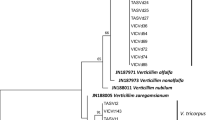Abstract
Classification of 32 Verticillium dahliae isolates originating from 19 plant species in eight different botanical families to races and determination of host range pathogenicity were carried out. The physiological races of isolates were identified using the two differential tomato cultivars ‘Belladonna’ (susceptible to both races 1 and 2 of V. dahliae) and ‘Ace 55VF’ (resistant to race 1, susceptible to race 2 of V. dahliae). Among these isolates, 14 were race 2 (43.8%), 12 race 1 (37.5%) and six nonpathogenic (18.7%) on tomato. The host range pathogenicity of isolates was determined using four differential hosts (eggplant, turnip, tomato (Ve −) and sweet pepper). Among isolates, five were pathogenic to both eggplant and turnip (15.6%), 21 to eggplant, turnip and tomato (65.6%), five to eggplant, turnip, tomato and sweet pepper (15.6%) and one was pathogenic to eggplant, turnip and sweet pepper (3.2%). The pathogenicity of isolates on the aforementioned five hosts was investigated on the basis of external symptoms and by calculating the relative areas under disease progress curves (relative AUDPC). Results showed that eggplant was the most susceptible, followed by turnip and tomato cv. Belladonna, while sweet pepper and tomato cv. Ace 55VF were less susceptible to all the isolates used. The pathogenicity of isolates varied from highly to mildly virulent on eggplant and turnip while on Belladonna, Ace 55VF and sweet pepper it varied from highly virulent to nonpathogenic. Belladonna exhibited a similar level of susceptibility to races 1 and 2 of V. dahliae, but was more susceptible than Ace 55VF to race 2. Interestingly, the isolates originating from eggplant were clearly more virulent than those originating from tomato and black nightshade on all solanaceous plants tested.





Similar content being viewed by others
References
Alexander, L. J. (1962). Susceptibility of certain Verticillium-resistant tomato varieties to an Ohio isolate of the pathogen. Phytopathology, 52, 998–1000.
Bender, C. G., & Shoemaker, P. B. (1984). Prevalence of Verticillium wilt of tomato and virulence of Verticillium dahliae race 1 and race 2 isolates in western North Carolina. Plant Disease, 68, 305–309.
Bhat, R. G., & Subbarao, K. V. (1999). Host range specificity in Verticillium dahliae. Phytopathology, 89, 1218–1225.
Blanco-Lopez, M. A., Bejarano-Alcazar, J., Melero-Vara, J. M., & Jimenez-Diaz, R. M. (1989). Current status of Verticillium wilt of cotton in southern Spain: Pathogen variation and population in soil. In E. C. Tjamos & C. H. Beckman (Eds.), Vascular wilt diseases of plants (pp. 123–132). New York, NY: Springer.
Campbell, C. L., & Madden, L. V. (1990). Introduction to plant disease epidemiology. New York, NY: Wiley.
Daayf, F., Nicole, M., & Geiger, J. P. (1995). Differentiation of Verticillium dahliae populations on the basis of vegetative compatibility and pathogenicity on cotton. European Journal of Plant Pathology, 101, 69–79.
Dervis, S., Yetisir, H., Yildirim, H., Tok, F. M., Kurt, S., & Karaca, F. (2009). Genetic and pathogenic characterization of Verticillium dahliae isolates from eggplant in Turkey. Phytoparasitica, 37, 467–476.
Grogan, R. G., Ioannou, N., Schneider, R. W., Sall, M. A., & Kimble, K. A. (1979). Verticillium wilt on resistant tomato cultivars in California: Virulence of isolates from plants and soil and relationship of inoculum density to disease incidence. Phytopathology, 69, 1176–1180.
Hagiwara, H. (1990). Differentiation of the pathogenicity of Verticillium dahliae in Japan. Plant Protection, 44, 299–303.
Horiuchi, S., Hagiwara, H., & Takeuchi, S. (1990). Host specificity of isolates of Verticillium dahliae towards cruciferous and solanaceous plants. In D. Hornby (Ed.), Biological control of soil-borne plant pathogens (pp. 285–298). Wallingford, UK: CAB International.
Horner, C. E. (1954). Pathogenicity of Verticillium isolates to peppermint. Phytopathology, 44, 239–242.
Jabnoun-Khiareddine, H., Daami-Remadi, M., & El Mahjoub, M. (2007). Incidence and distribution of Verticillium dahliae races infecting tomato in Tunisia. Tunisian Journal of Plant Protection, 2, 63–70.
Jimenez-Diaz, R. M., Mercado-Blanco, J., Olivares-Garcia, C., Collado-Romero, M., Bejarano-Alcazar, J., Rodriguez-Jurado, D., et al. (2006). Genetic and virulence diversity in Verticillium dahliae populations infecting artichoke in eastern-central Spain. Phytopathology, 96, 288–298.
Karapapa, V. K., Bainbridge, B. W., & Heale, J. B. (1997). Morphological and molecular characterization of Verticillium longisporum comb. nov., pathogenic to oilseed rape. Mycological Research, 101, 1281–1294.
Komatsu, T., Sumino, A., & Kageyama, K. (2001). Characterization of Verticillium dahliae isolates from potato on Hokkaido by random amplified polymorphic DNA (RAPD) and REP-PCR analyses. Journal of General Plant Pathology, 67, 23–27.
Korolev, N., Perez-Artes, E., Bejarano-Alcazar, J., Rodrıguez-Jurado, D., Katan, J., Katan, T., et al. (2001). Comparative study of genetic diversity and pathogenicity among populations of Verticillium dahliae from cotton in Spain and Israel. European Journal of Plant Pathology, 107, 443–456.
Korolev, N., Katan, T., & Katan, J. (2009). Physiological races and vegetative compatibility groups among Verticillium dahliae isolates from tomato in Israel. ISHS, Acta Horticulturae, 808, 57–64.
Ligoxigakis, E. K., & Vakalounakis, D. J. (1992). Occurrence of race 2 of Verticillium dahliae on tomatoes in Crete. Plant Pathology, 41, 774–776.
Ligoxigakis, E. K., & Vakalounakis, D. J. (1994). The incidence and distribution of races of Verticillium dahliae in Crete. Plant Pathology, 43, 755–758.
Ligoxigakis, E. K., Vakalounakis, D. J., & Thanassoulopoulos, C. C. (2002a). Host range of Verticillium dahliae in cultivated species in Crete. Phytoparasitica, 30, 141–146.
Ligoxigakis, E. K., Vakalounakis, D. J., & Thanassoulopoulos, C. C. (2002b). Weed hosts of Verticillium dahliae in Crete: Susceptibility, symptomatology and significance. Phytoparasitica, 30, 511–518.
Markakis, E. A., Tjamos, S. E., Antoniou, P. P., Paplomatas, E. J., & Tjamos, E. C. (2009). Symptom development, pathogen isolation and real-time qPCR quantification as factors for evaluating the resistance of olive cultivars to Verticillium pathotypes. European Journal of Plant Pathology, 124, 603–611.
Maruthachalam, K., Atallah, Z. K., Vallad, G. E., Klosterman, S. J., Hayes, R. J., Davis, R. M., et al. (2010). Molecular variation among isolates of Verticillium dahliae and polymerase chain reaction-based differentiation of races. Phytopathology, 100, 1222–1230.
Oshima, S., Arai, H., Nagao, H., & Hasegawa, M. (1993). Pathogenicity of a newly isolated Verticillium dahliae from sweet pepper (Capsicum annuum L.). Annual Meeting of Phytopathological Society of Japan, 59, 59.
Pegg, G. F., & Brady, B. L. (2002). Verticillium wilts. Wallingford, UK: CABI Publishing.
Qin, Q. M., Vallad, G. E., Wu, B. M., & Subbarao, K. V. (2006). Phylogenetic analyses of phytopathogenic isolates of Verticillium. Phytopathology, 96, 582–592.
Resende, M. L. V., Flood, J., & Cooper, R. M. (1994). Host specialization of Verticillium dahliae, with emphasis on isolates from cocoa (Theobroma cacao). Plant Pathology, 43, 104–111.
Schaible, L., Cannon, O. S., & Waddoups, V. (1951). Inheritance of resistance to Verticillium wilt in a tomato cross. Phytopathology, 41, 986–990.
Schnathorst, W. C. (1981). Life cycle and epidemiology of Verticillium. In M. A. Mace, A. A. Bell, & C. H. Beckman (Eds.), Fungal wilt diseases of plants (pp. 81–111). New York, NY: Academic Press.
Stark, C. (1961). Das Aufreten der Verticillium-Tracheomykosen in Hamburger Gartenbaukulturen. Ein Beitrag zur Kenntnisihrer Erreger. Gartenbauwissenschaft, 26, 493–528.
Taylor, J. B. (1969). Host specificity of Verticillium dahliae to tobacco. New Zealand Journal of Science, 12, 709–712.
Tjamos, E. C. (1980). Occurrence of race 2 of Verticillium dahliae in Greece. Annales de l’ Institut Phytopathologique Benaki (N.S.), 12, 216–226.
Tjamos, E. C. (1981). Virulence of Verticillium dahliae and V. albo-atrum isolates in tomato seedlings in relation to their host of origin and the applied cropping system. Phytopathology, 71, 98–100.
Usami, T., Shishido, M., Ebihara, Y., Kamigahira, Y., & Amemiya, Y. (2005). Retrotransposon-like elements in the genome of Verticillium dahliae may be used as DNA markers for fungal species and pathotypes. Journal of General Plant Pathology, 71, 117–123.
Usami, T., Ishigaki, S., Takashina, H., Matsubara, Y., & Amemiya, Y. (2007). Cloning of DNA fragments specific to the pathotype and race of Verticillium dahliae. Journal of General Plant Pathology, 73, 89–95.
Usami, T., Fukaya, M., & Amemiya, Y. (2008). Electrophoretic karyotyping and mapping of pathotype-specific DNA sequences in Japanese isolates of Verticillium dahliae. Journal of General Plant Pathology, 74, 61–65.
Zeise, K., & von Tiedemann, A. (2002). Host specialization among vegetative compatibility groups of Verticillium dahliae in relation to Verticillium longisporum. Journal of Phytopathology, 150, 112–119.
Author information
Authors and Affiliations
Corresponding author
Rights and permissions
About this article
Cite this article
Ligoxigakis, E.K., Markakis, E.A. Incidence and pathogenicity of races and isolates of Verticillium dahliae in Crete, southern Greece. Phytoparasitica 40, 493–506 (2012). https://doi.org/10.1007/s12600-012-0250-4
Received:
Accepted:
Published:
Issue Date:
DOI: https://doi.org/10.1007/s12600-012-0250-4




